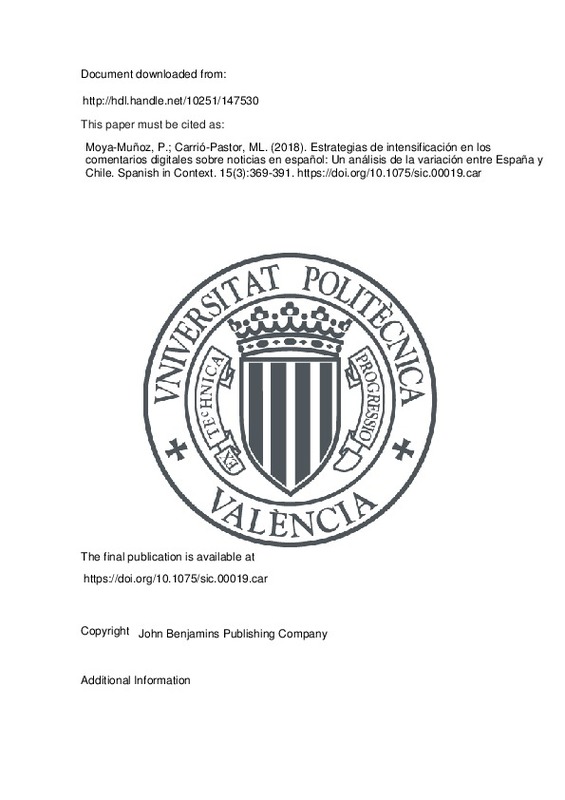Aijón Oliva, M. A. (2013). On the meanings and functions of grammatical choice. Pragmatics, 23(4), 573-603. doi:10.1075/prag.23.4.01aij
Alonso Almeida, F., & Carrió Pastor, M. (2015). Sobre la categorización de seem en inglés y su traducción en español: Análisis de un corpus paralelo. Revista signos, 48(88), 154-173. doi:10.4067/s0718-09342015000200001
Aparici, R., & Osuna Acedo, S. (2013). La cultura de la participación. Revista Mediterránea de Comunicación, 4(2). doi:10.14198/medcom2013.4.2.07
[+]
Aijón Oliva, M. A. (2013). On the meanings and functions of grammatical choice. Pragmatics, 23(4), 573-603. doi:10.1075/prag.23.4.01aij
Alonso Almeida, F., & Carrió Pastor, M. (2015). Sobre la categorización de seem en inglés y su traducción en español: Análisis de un corpus paralelo. Revista signos, 48(88), 154-173. doi:10.4067/s0718-09342015000200001
Aparici, R., & Osuna Acedo, S. (2013). La cultura de la participación. Revista Mediterránea de Comunicación, 4(2). doi:10.14198/medcom2013.4.2.07
Carrió-Pastor, M. L., & Calderón, R. M. (2015). A Contrastive Analysis of Metadiscourse Features in Business e-mails Written by Non-native Speakers of English. Procedia - Social and Behavioral Sciences, 173, 214-221. doi:10.1016/j.sbspro.2015.02.055
Carrió-Pastor, M. L., & Muñiz-Calderón, R. (2015). Identification and causes of lexical variation in Chinese Business English. English Today, 31(1), 10-15. doi:10.1017/s0266078414000480
Casero-Ripollés, A. (2012). Nuevas formas de producción de noticias en el entorno digital y cambios en el periodismo: el caso del 15-M. Comunicación y Hombre, (8), 129-140. doi:10.32466/eufv-cyh.2012.8.150.129-140
Davidson, B. (1996). ‘Pragmatic weight’ and Spanish subject pronouns: The pragmatic and discourse uses of ‘tú’ and ‘yo’ in spoken Madrid Spanish. Journal of Pragmatics, 26(4), 543-565. doi:10.1016/0378-2166(95)00063-1
De Cock, B. (2011). Why we can be you: The use of 1st person plural forms with hearer reference in English and Spanish. Journal of Pragmatics, 43(11), 2762-2775. doi:10.1016/j.pragma.2011.04.009
Figueras Bates, C. (2015). PRAGMÁTICA DE LA PUNTUACIÓN Y NUEVAS TECNOLOGÍAS. Normas, 4(1), 135. doi:10.7203/normas.4.4691
Gillaerts, P., & Van de Velde, F. (2010). Interactional metadiscourse in research article abstracts. Journal of English for Academic Purposes, 9(2), 128-139. doi:10.1016/j.jeap.2010.02.004
González Arias, C. (2014). El metadiscurso en columnas de opinión y en los comentarios de lectores en un ambiente virtual y público. Spanish in Context, 11(2), 155-174. doi:10.1075/sic.11.2.01gon
Hermida, A. (2011). Mechanisms of Participation. Participatory Journalism, 11-33. doi:10.1002/9781444340747.ch2
Hu, G., & Cao, F. (2011). Hedging and boosting in abstracts of applied linguistics articles: A comparative study of English- and Chinese-medium journals. Journal of Pragmatics, 43(11), 2795-2809. doi:10.1016/j.pragma.2011.04.007
HYLAND, K. (1998). Boosting, hedging and the negotiation of academic knowledge. Text - Interdisciplinary Journal for the Study of Discourse, 18(3). doi:10.1515/text.1.1998.18.3.349
Hyland, K. (2004). Disciplinary interactions: metadiscourse in L2 postgraduate writing. Journal of Second Language Writing, 13(2), 133-151. doi:10.1016/j.jslw.2004.02.001
Hyland, K. (2015). Metadiscourse. The International Encyclopedia of Language and Social Interaction, 1-11. doi:10.1002/9781118611463.wbielsi003
Hyland, K. (2004). Metadiscourse in Academic Writing: A Reappraisal. Applied Linguistics, 25(2), 156-177. doi:10.1093/applin/25.2.156
Kuo, C.-H. (1999). The Use of Personal Pronouns: Role Relationships in Scientific Journal Articles. English for Specific Purposes, 18(2), 121-138. doi:10.1016/s0889-4906(97)00058-6
Leedham, M., & Fernandez-Parra, M. (2017). Recounting and reflecting: The use of first person pronouns in Chinese, Greek and British students’ assignments in engineering. Journal of English for Academic Purposes, 26, 66-77. doi:10.1016/j.jeap.2017.02.001
Li, T., & Wharton, S. (2012). Metadiscourse repertoire of L1 Mandarin undergraduates writing in English: A cross-contextual, cross-disciplinary study. Journal of English for Academic Purposes, 11(4), 345-356. doi:10.1016/j.jeap.2012.07.004
Mur-Dueñas, P. (2011). An intercultural analysis of metadiscourse features in research articles written in English and in Spanish. Journal of Pragmatics, 43(12), 3068-3079. doi:10.1016/j.pragma.2011.05.002
Pano, A. (2008). Dialogar en la Red. doi:10.3726/978-3-0351-0482-0
Posio, P. (2011). Spanish subject pronoun usage and verb semantics revisited: First and second person singular subject pronouns and focusing of attention in spoken Peninsular Spanish. Journal of Pragmatics, 43(3), 777-798. doi:10.1016/j.pragma.2010.10.012
Posio, P. (2014). Subject expression in grammaticalizing constructions: The case of creo and acho ‘I think’ in Spanish and Portuguese. Journal of Pragmatics, 63, 5-18. doi:10.1016/j.pragma.2013.07.001
Posio, P. (2016). You and we: Impersonal second person singular and other referential devices in Spanish sociolinguistic interviews. Journal of Pragmatics, 99, 1-16. doi:10.1016/j.pragma.2016.04.014
Reich, Z. (2011). User Comments. Participatory Journalism, 96-117. doi:10.1002/9781444340747.ch6
Serrano, M. J., & Oliva, M. Á. A. (2014). Discourse objectivization, social variation and style of Spanish second-person singular tú. Folia Linguistica, 48(1), 225-254. doi:10.1515/flin.2014.007
Stewart, M. (2003). ‘Pragmatic weight’ and face: pronominal presence and the case of the Spanish second person singular subject pronoun tú. Journal of Pragmatics, 35(2), 191-206. doi:10.1016/s0378-2166(02)00083-8
[-]







![[Cerrado]](/themes/UPV/images/candado.png)


